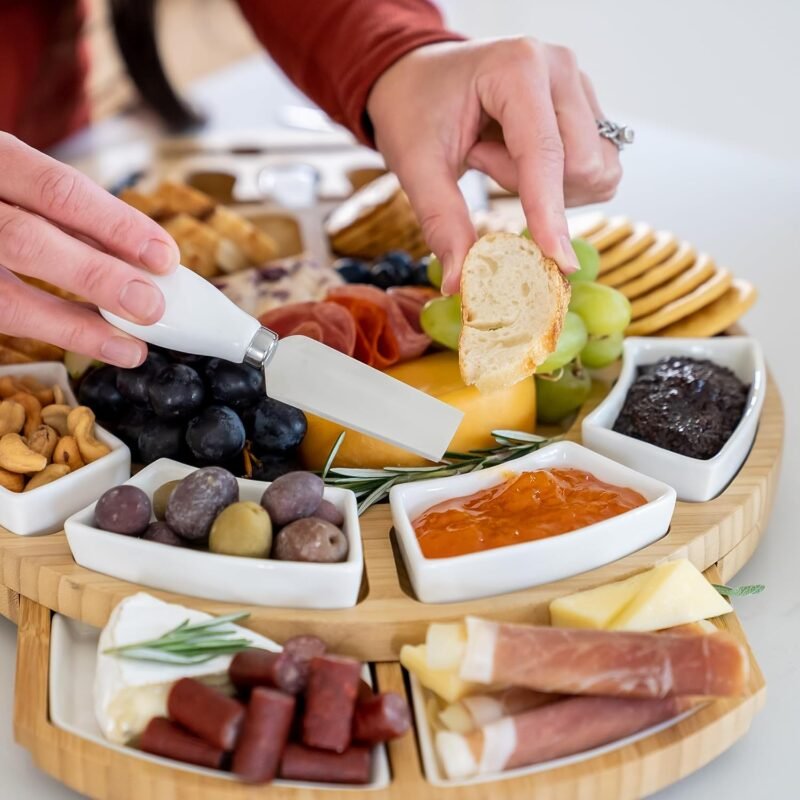If you’re a fan of cheese, you’re probably no stranger to the pleasure of cutting and serving it with the perfect knife. While it’s tempting to grab any knife for the job, using a basic kitchen knife or a dull tool can make the process more challenging than it needs to be.
To get the most out of your cheese experience, a dedicated cheese knife set is a great investment. But with so many types and styles out there, how do you choose the right one for your needs? We’ve got you covered with some helpful tips on picking the perfect set and maintaining its quality.
Different Types of Cheese Knife Sets
The right cheese knife depends largely on the type of cheese you’re working with. Various knives are designed to cater to specific cheeses, ensuring you can serve them properly.
- Cheese Plane/Slicer
Ideal for slicing semi-hard to hard cheeses like cheddar or gouda. A cheese plane creates uniform slices, making it a professional choice for smooth, clean cuts. - Soft Cheese Knife
For soft cheeses like Brie or Camembert, these knives feature a sharp edge that slices through delicate textures without the cheese sticking to the blade. Wooden-handled knives can enhance both aesthetics and functionality. - Cheese Cleaver
This knife is perfect for cutting firm cheeses like Brick or Gouda into large chunks. Resembling a small meat cleaver, it’s designed to handle the tough task of dividing larger blocks with ease. - Pronged Knife
Known as the all-rounder, a pronged knife works well with a variety of cheeses, from crumbly cheddar to soft feta. The prongs make it easy to serve cheese, though it’s not the best choice for extremely hard cheeses like Parmesan. - Flat Cheese Knife
Often referred to as a cheese chisel, this knife is ideal for shaving or cutting hard cheeses like aged cheddar. The flat blade allows you to apply force directly, slicing off clean pieces without crumbling the cheese.
How to Choose a Cheese Knife Set?
When selecting a cheese knife set, think about the durability and versatility that will enhance your cheese-serving experience.
- Opt for High-Quality Materials
Look for knives made from stainless steel for sharpness and durability. A well-made set will last longer and provide smoother cuts. - Consider Comfortable Handles
Ergonomically designed handles ensure a comfortable grip, which is especially important when you’re serving cheese for an extended period. - Variety of Blades
A set that includes multiple knife types—such as a soft cheese knife, slicer, and cleaver—will help you tackle a variety of cheeses with ease. - Versatility
Versatile knives that can serve multiple purposes—such as cutting, spreading, and serving—are a good investment, as they offer more value than single-function knives.

Caring for Your Cheese Knives
To maintain the longevity and effectiveness of your knives, proper care is essential.
- Keep Knives Clean and Sharp
Regularly sharpen your knives to prevent tearing or sticking when cutting. You can also take them to a professional sharpener once a year. Hand washing with a damp cloth after each use is essential for keeping your knives in top condition. - Avoid Cutting on Hard Surfaces
Never cut on glass or ceramic surfaces, as they can damage the blades. A dedicated cheese board will protect your knives and ensure smooth cuts. - Use the Right Knife for the Right Cheese
Match your knives to the cheese you’re cutting. Soft cheeses require thin, sharp blades, while harder varieties need sturdier, more robust knives. - Store Knives Properly
To prevent damage and accidents, store your cheese knives in a designated case or drawer, away from other utensils.
Common FAQs About Cheese Knives
Here are some common questions about cheese knives and their answers:
- What knives are best for cutting cheese?
For hard cheeses, a small paring knife works best, while soft cheeses can be sliced with a thin kitchen knife. - Why are there different shapes of cheese knives?
Like chefs use various knives for different tasks in cooking, cheese knives are designed for specific textures—thin blades for soft cheeses and sturdy blades for hard ones. - Why do most cheese knives have holes?
Holes reduce the surface area, which prevents cheese from sticking to the blade, making slicing easier. - How many cheese knives do you need?
A set of three knives—one for hard cheeses, one for semi-hard cheeses, and one for soft cheeses—should cover most needs. - Do cheese knives need to be sharpened regularly?
Yes, sharpening once a year at home (or by a professional) will keep your knives in great shape for effortless slicing.
With these tips in mind, you’ll be well-equipped to choose and care for your cheese knife set, ensuring every cheese experience is delightful and hassle-free!






